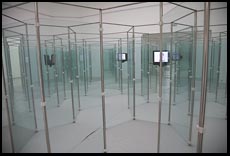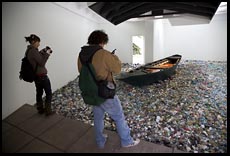
Art and the Venice Biennale
by Philip Greenspun; revised December 2007
"When we see a monk going about with a lion and looking tranquilly up to heaven, we know that that is St. Mark. When we see a monk with a book and a pen, looking tranquilly up to heaven, trying to think of a word, we know that that is St. Matthew. When we see a monk sitting on a rock, looking tranquilly up to heaven, with a human skull beside him, and without other baggage, we know that is St. Jerome. Because we know that he always went flying light in the matter of baggage. When we see a party looking tranquilly up to heaven, unconscious that his body is shot through and through with arrows, we know that that is St. Sebastian. ... We have seen thirteen thousand St. Jeromes, and twenty-two thousand St. Marks, and sixteen thousand St. Matthews, and sixty thousand St. Sebastians, and four millions of assorted monks, undesignated, and we feel encouraged to believe that when we have seen some more of these various pictures, and had a larger experience, we shall begin to take an absorbing interest in them..."
-- Mark Twain in the Venice section of Innocents Abroad (1869)

Some of the world's best and largest scale oil paintings were commissioned for Venetian palaces and remain in place in such magnificent settings as the Scuola Grande di San Rocco (Tintoretto's 54-painting cycle) and the Palazzo Ducale (world's largest oil painting, Paradiso by Tintoretto). Venice also has important art collections at museums such as the Accademia (old stuff) and the Peggy Guggenheim (new stuff). These are all great tourist sights, covered superbly in many guidebooks, but they aren't very significant for photographers. First, photography is forbidden inside nearly all of the Venetian art museums and the Palazzo Ducale. Second, photographs of paintings aren't usually very interesting.
What art in Venice makes for interesting photographic subjects? La Biennale, the art show that has been held in odd-numbered years since 1895. The art installations tend to be large and strange and, at least in 2007, photography was permitted within all of the Biennale venues. The Biennale runs from early in the summer (packed and hot) to late November (quiet and cool). Start your Biennale tour with a trip to the Giardini, at the eastern tip of Castello. The early participating countries each built a pavilion within this garden and typically each pavilion presents the work of between one and three artists. The next major venue is the Arsenale, which is more like a standard museum. You need tickets for the Giardini and Arsenale (a "permanent ticket" is about 40 euro and can be purchased on the Web in advance). Countries that didn't exist in 1895 or that couldn't get space within the Giardini will rent palazzos and other spaces around the city for the duration of the event. These auxiliary venues do not require a ticket or payment. If 2007's high-tech show by Rafael Lozano-Hemmer was anything to go by, don't miss whatever Mexico is doing.
[In 2007, some of the most interesting work within the Giardini was at the Russian pavilion. Venezuela also had a strong showing. The West African artists exhibiting in the Arsenale were also very interesting, pointing to the benefits to artists of living in an oil-rich kleptocracy. The U.S. pavilion was entirely given over to Felix Gonzalez-Torres. One reviewer said "In an era of globalization and post colonialism as dominant concepts of current critical thinking it is significant to note that the artist representing the Unites States was born in Cuba. To proceed further he is the second deceased artist to represent his (adopted) nation, the first was Robert Smithson in 1982. The artist (1957-1996) died of AIDS and it is relevant to note this as it informs aspects of the work which are at the core of his art practice." [source] Maybe someone with a Ph.D. in art criticism would have found the actual exhibit interesting...]
Biennale Practicalities: Stay at the Londra Palace, one of the closest good hotels to the Giardini (see Venice Hotels for details). Avoid the airport-style food within the Giardini and head over to the nearby Secco Marina street for lunch at the Trattoria/Pizzeria dai Tosi (closed Wednesday) or to the Quartiere Sant'Elena to Osteria Sant'Elena/Dal Pampo (closed Tuesday) on Calle Chinotto. Mexico, one of the world's greatest art countries, does not have a pavilion within the garden, so make sure to seek out whatever palazzo the Mexican art officials have rented for the occasion.
"Among the Italian schools of painting the Venetia has, for the majority of art-loving people, the strongest and most enduring attraction. ...
The Venetians as a school were from the first endowed with exquisite tact in their use of color. Seldom cold and rarely too warm, their coloring never seems an afterthought, as in many of the Florentine painters, not is it always suggesting paint, as in some of the Veronese masters. ... The better Venetian paintings present such harmony on intention and execution as distinguishes the highest achievements of genuine poets.
-- Bernard Berenson (1865-1959), in The Venetian Painters of the Renaissance (1894)